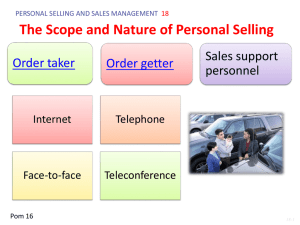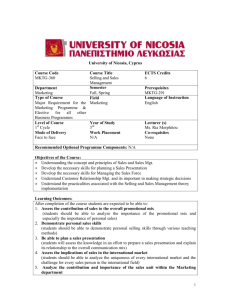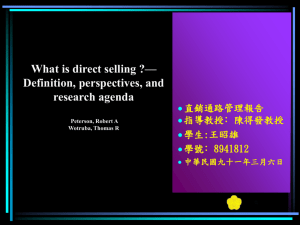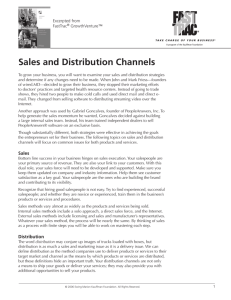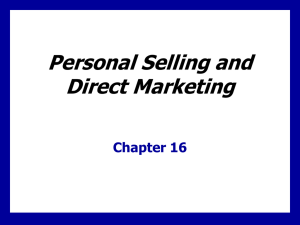File
advertisement
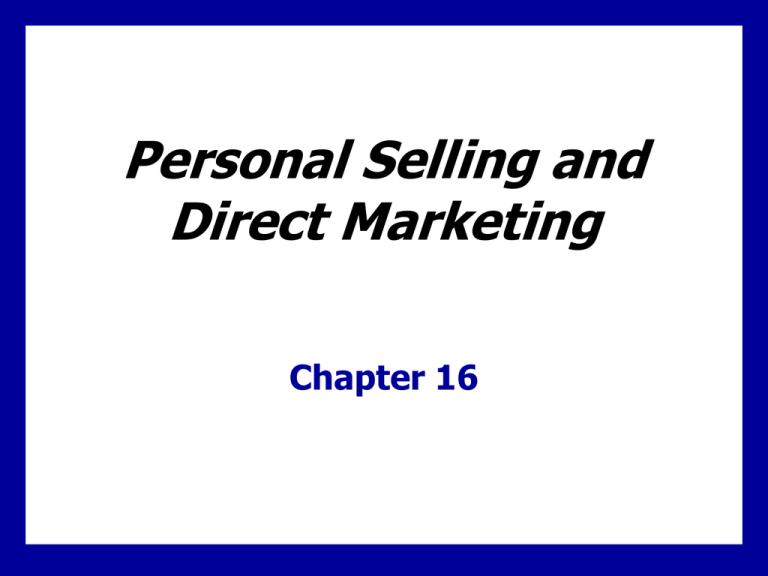
Personal Selling and Direct Marketing Chapter 16 Personal Selling The Nature of Personal Selling Salesperson covers a wide range of positions from order taker to order getter responsible for relationship building 16 - 1 Goal 1: Understand the role of the salespeople in creating value Personal Selling Salespeople Have Many Names • Agents • Sales Consultants • Sales Representatives • Account Executives • Sales Engineers • District Managers • Marketing Representatives • Account Development Representatives 16 - 2 Goal 1: Understand the role of the salespeople in creating value Personal Selling The Role of the Sales Force Two-way personal communication More effective than advertising in complex selling situations The sales force plays a major role in most companies The sales force represents the company to customers 16 - 3 Goal 1: Understand the role of the salespeople in creating value Definition Sales Force Management The analysis, planning, implementation, and control of sales force activities Goal 2: Know the six major sales force management steps 16 - 4 Managing the Sales Force Sales Force Strategy and Structure Sales Force Structure • • • • Territorial sales force structure Product sales force structure Customer sales force structure Complex sales force structure Goal 2: Know the six major sales force management steps 16 - 5 Managing the Sales Force Sales Force Strategy and Structure Sales Force Size • Many companies use the workload approach to set sales force size Other Issues • Outside and inside sales forces • Team selling Goal 2: Know the six major sales force management steps 16 - 6 Managing the Sales Force Recruiting and Selecting Salespeople Careful recruiting can: • Increase overall sales force performance • Reduce turnover • Reduce recruiting and training costs Goal 2: Know the six major sales force management steps 16 - 7 Managing the Sales Force Traits of Successful Salespeople • • • • Intrinsic motivation Disciplined work style The ability to close a sale Ability to build relationships with customers Goal 2: Know the six major sales force management steps 16 - 8 Managing the Sales Force Training Salespeople Training period can be anywhere from a few weeks to a year or more Training is expensive, but yields strong returns Training programs have many goals Many companies are adding Webbased sales training programs Goal 2: Know the six major sales force management steps 16 - 9 Managing the Sales Force Compensating Salespeople Compensation elements: salary, bonuses, commissions, expenses, and fringe benefits Basic compensation plans: • • • • Straight salary Straight commission Salary plus bonus Salary plus commission Compensation plans should direct the sales force toward activities that are consistent with overall marketing objectives. Goal 2: Know the six major sales force management steps 16 - 10 Managing the Sales Force Supervising Salespeople Effective supervisors provide direction to the sales force • Annual call plans and time-and-duty analysis can help provide direction • Sales force automation systems assist in creating more efficient sales force operations Goal 2: Know the six major sales force management steps 16 - 11 Managing the Sales Force Supervising Salespeople Effective supervisors also motivate the sales force • Organizational climate • Sales quotas • Positive incentives – Sales meetings, sales contests, honors, etc. Goal 2: Know the six major sales force management steps 16 - 12 Managing the Sales Force Evaluating Salespeople Several tools can be used • Sales reports • Call reports • Expense reports Goal 2: Know the six major sales force management steps 16 - 13 The Personal Selling Process Prospecting and Qualifying Prospecting: identifying potential customers Qualifying: Screening leads Preapproach Learning as much as possible about a prospective customer prior to making a sales call Approach Stage where the salesperson meets the customer for the first time 16 - 14 Goal 3: Understand the personal selling process The Personal Selling Process Presentation and Demonstration Benefits of the product are presented/demonstrated Understanding prospect needs is key Handling Objections and Closing Asking for the order Follow-up Helps ensure customer satisfaction 16 - 15 Goal 3: Understand the personal selling process Definition Direct Marketing Consists of direct one-to-one connections with carefully targeted individual consumers to both obtain an immediate response and cultivate lasting customer relationships. 16 - 16 Goal 4: Learn about direct marketing and its benefits


